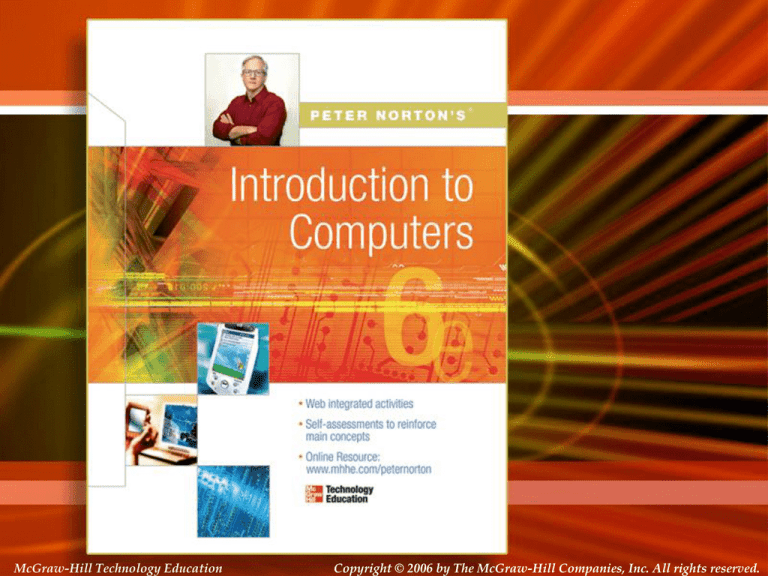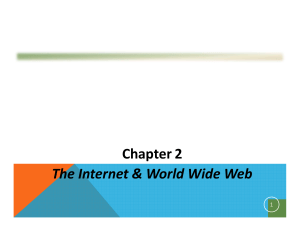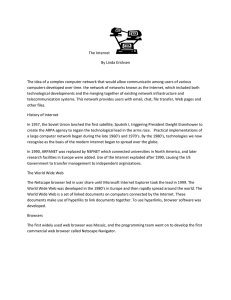
McGraw-Hill Technology Education
McGraw-Hill Technology Education
Copyright © 2006 by The McGraw-Hill Companies, Inc. All rights reserved.
Copyright © 2006 by The McGraw-Hill Companies, Inc. All rights reserved.
Chapter 2A
The Internet and the
World Wide Web
McGraw-Hill Technology Education
Copyright © 2006 by The McGraw-Hill Companies, Inc. All rights reserved.
The Internet’s History
• 1969 – ARPANET
– Developed by the Department of Defense
– Connected universities and defense bases
• 1973 – ARPANET connects to Europe
2A-3
ARPANET 1973
2A-4
The Internet’s History
• Mid-1980s – NSFNet
– Network between supercomputers
– Internet was the link to ARPANET
– No commercial traffic allowed
• 1990s
– ARPANET shut down
– NSFNet abandoned
– Commercial networks take over
2A-5
Today and the Future
• 100,000 new web sites per month
• More than 50% of U.S. households
online
• Access is available throughout the U.S.
• Eventually access will be global
2A-6
U.S. Internet Growth
2A-7
The Internet’s Major Services
• The World Wide Web (WWW)
– Developed in 1993 by Tim-Berners Lee
– Allowed connection of documents
– Required a browser to read documents
• Electronic mail (e-mail)
– Instantaneous transmission of documents
2A-8
The Internet’s Major Services
• News
– Often called newsgroups
– Electronic discussions on several topics
• File Transfer Protocol (FTP)
– Sends and receives files
2A-9
The Internet’s Major Services
• Chat
– Public real time conversation
• Instant messaging
– Private real time conversation
• Peer-to-peer services
– Allows sharing of files among users
– Napster and Kazaa are examples
– Illegal to share copyrighted material
2A-10
Accessing The Internet
• Internet Service Provider (ISP)
– Company that provides Internet access
• Dialup
– Connects to Internet through phone line
– Modem connects to the phone line
– Slow connection
2A-11
Accessing The Internet
• High-speed access
– Connect through a special line
– 2 – 25 times faster than dialup
– DSL, Cable, T1 are common
2A-12
Understanding the Internet
• The Internet allows accessing resources
• The Web simplifies the Internet
• The Web connects documents
– Hypertext creates links between documents
– Documents are stored on a web server
– HTTP delivers documents
2A-13
Understanding the Internet
• Web site is a collection of documents
– Document is a web page
– Pages are published to the web
• Hypertext Markup Language
– Creates web pages
– Describes how pages should look
– Content enclosed in tags
– <tag>content</tag>
2A-14
Understanding The Internet
• Browsers
– Read and translate the HTML
– Display web content
• Uniform Resource Locator (URL)
– Address of a web page
2A-15
Understanding The Internet
• Helper applications
– Plug-ins
– Enhance a browser’s functionality
• Streaming audio and video
– Sends the file in small chunks
– Chunks downloaded while others play
2A-16
Streaming Audio
2A-17
Using a Browser And The WWW
• Browser starts on the home page
• Navigating the web
– Enter a URL in the browser
– Click a link
– Links are typically blue underlined words
– Image maps are picture links
• When finished, close the browser
2A-18
Searching the Web
• The Web is unorganized
• Directories
– Categorize the Internet
• Search engines
– Find sites by keyword
2A-19
Searching the Web
• Site searches
– Large sites have an internal search
• Metasearch sites
– Search several web sites at once
• Sponsored links
– Sites pay for better search results
2A-20
Search Techniques
•
•
•
•
•
2A-21
Quote the exact phrase
Use the keyword AND
Use the keyword NEAR
Avoid common words
Use the site’s advanced tools
Chapter 2A
End of Chapter
McGraw-Hill Technology Education
Copyright © 2006 by The McGraw-Hill Companies, Inc. All rights reserved.





